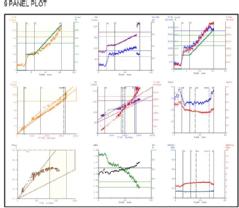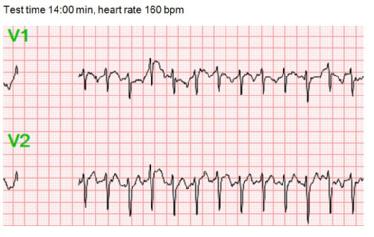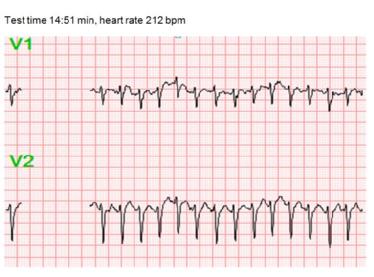The case
Description
- This male amateur athlete (55 years, BMI 23.15 kg/m2) presented with palpitations during bike rides
- He described a rapid increase in heart rate up to 210 bpm, documented by his training monitor, associated with a feeling of loss of performance.
- The patient has a history of mitral regurgitation secondary to a mitral valve prolapse of the posterior leaflet, for which he underwent mitral valve reconstruction one year ago.
- The patient used to exercise 3 times per week for 2 to 4 hours per session (skiing and biking). Currently he is not on any medication.
- A recently performed 24-hour ambulatory ECG revealed some premature ventricular beats.
- A transthoracic echocardiography showed mildly dilated atria and ventricles, a normal left ventricular ejection fraction and a good mitral valve function without relevant regurgitation.
- The family history includes a sudden cardiac death of a brother at the age of 57 years.
- A cardiopulmonary exercise test was performed for further investigation.
Test findings
- The 9-plot analysis documented an above-average exercise capacity with 278 Watt (135 % predicted), and a peak VO2 of 38 ml/min/kg (120 % predicted) (Panel 3).
- The O2 pulse (VO2/heart rate) (Panel 2) increased to above average values with a sudden drop at the end of the test. VO2 increased parallel to the work load with a sudden drop at the end of the test (Panel 3).
- Exercise ECG revealed a sudden increase in heart rate at the end of the test but no exercise-induced ischemia. Blood pressure increased gradually from 130/80 mmHg at rest to 195/80 mmHg at peak exercise.
- There were no pathologic findings with regard to respiratory efficiency (VE/VCO2 slope, Panel 4), PETCO2 progress (Panel 9), breathing reserve (Panel 8) and resting pulmonary function test.

ECG during exercise


Test your knowledge
Interested in learning more?
Access the ESC e-learning platform on Prevention with its 17 new courses in Sports Cardiology.
Not yet an EAPC member?
Note: The views and opinions expressed on this page are those of the author and may not be accepted by others. While every attempt is made to keep the information up to date, there is always going to be a lag in updating information. The reader is encouraged to read this in conjunction with appropriate ESC Guidelines. The material on this page is for educational purposes and is not for use as a definitive management strategy in the care of patients. Quiz material in the site are only examples and do not guarantee outcomes from formal examinations.


 Our mission: To reduce the burden of cardiovascular disease.
Our mission: To reduce the burden of cardiovascular disease.